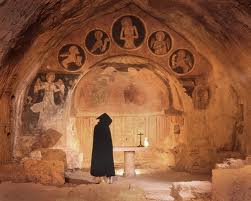Every time we look at the heritage of our past, we know, we retrace deeds and stories of men. But what is very fascinating in Narni Underground is that these men have a name and a surname, and wait for us to tell their story.
Narnia, which takes its name from the river Nera (Naar, river) that flows at its bottom, is a city of charm, rich in history and architectural and artistic treasures, its complex morphology makes it extremely attractive for the beauty you can enjoy turning every corner.
The memory of Dominican Monastery, the seat of the Holy Office in Narni which was destroyed during the Second World War, apparently, faded very soon.
The tour begins in a church that was completely covered with frescoes. With a painted ceiling with a starry sky , the moon and the sun, even if the decoration is partially disappeared.
It’s still possible to admire the Coronation of Mary and the symbols of the four evangelists, a crucified Christ and St. Michael the Archangel to whom the church was dedicated, located along the road connecting the shrines dedicated to the Angel, from Mont Saint Michel in France and Monte San’Angelo in Puglia region in South Italy.
In a second room from Roman times, with the help of Tizius it’s possible to learn the use of a groma, an ancient instrument invented by the Romans to exactly track the territory alignments perpendicular to each other; in Narni this instruments was used to build an aqueduct, partially underground, 13 km long. The underground part of the acqueduct can be visited by appointment. In another room the visitor jumps to XVIII century… in the rooms of the Inquisition, more precisely in the picturesque torture chamber. The original ring, used for the torture of the rope, is hanging from the ceiling, and other instruments, not found on site, are on display.
In Narni, the knowledge of the Holy Office was totally lost, no document was known until the discovery of these rooms, although it was active until 1800. Almost all of the documents from the Vatican, brought to France by Napoleon, were destroyed, but something has been saved, so we cn earn the story of Domenico Ciabocco, a bigamist murderer sentenced to the galleys for life. The proceedings of his trial are the only document that had been saved in its entirety among the thousands destroyed.
Thirty-three years later in the same cells, was locked up another man, the most enigmatic and fascinating: Giuseppe Andrea Lombardini. The research about him are still pending. Far from being ignorant, of high culture, from the evidence that heleaved, he covered the walls of the cell with Masonic and alchemical symbols. He desperately tried to send his message and his cry of pain to us. He wrote the word “innocent” and the word was abraded from the wall, then covered the surface of the walls and ceiling with squares, triangles, trees of life, sun, moon… All symbols that imply the elevation to Paradise and the drive toward perfection.
You will be amazed to look around, once inside, trying to identify every symbol, every word, every sense. No sign is drawn at random, and you remain totally mesmerized by the desperate intention to leave us a message. I leave to others the detailed description of what I am admiring in the cell, there is enough to write a treatise. But the experience is truly unique.
The tour ends in a church, now used as a conference room, where it’s possible to admire a portion of the mosaic floor of the sixth century of the ancient cathedral of Narni , which stood in this place.
The discovery of the beautiful Byzantine mosaic work is due to the tireless work of the Association Narni Underground, as the excavations and discoveries that are not absolutely finished. Thanks to the enthusiasm and the passion of those guys who, in the ’70s, began this adventure, Narni Underground will always tell new stories, of life and of men.
by Benedetta Tintillini
Find Narni Underground on Google Maps:



